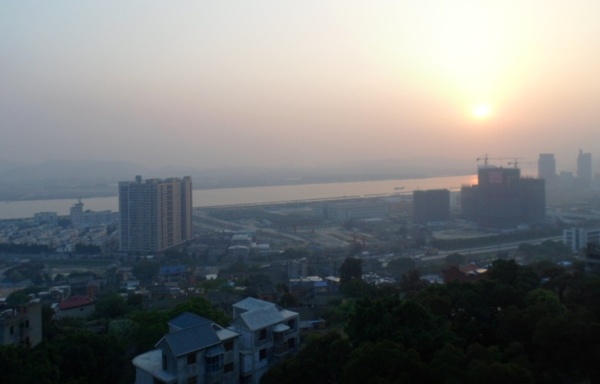
到底中國追求發展的代價有多大?有兩個指標可以看看:中國的天空和街上帶口罩的群眾。 不久前(2014年十一月),領導同志立願要減低CO2排放,但 PM 2.5 微粒空氣浮懸物怎麼辦? 最近 (2015年三月一日),紐約時報有一則報導(請看以下連結,也可看看視頻),顯示中國霧霾的嚴重性,其實這早已不是新聞,從2010年以來,就常在國際傳媒上有報導,只是同胞们未必知道真相,幾次到中國訪晤,與友人談起霧霾與各種污染問題,由於資訊受限制,多數只知局部現象或根本不知情。這一次紐時的消息,是根據中國民間製作的訪查而作成,製作人她很完整深入的呈現了真相,很難得的是能在網路上流傳開來(據說已受到關切,不易上線了),引起廣大群眾的關注。
http://sinosphere.blogs.nytimes.com/2015/03/01/documentary-on-air-pollution-in-china-grips-a-nation/?ref=science
在工業發達城區,空氣浮懸微粒 ( PM) 一向是健康殺手,看不見卻無所不在,它的來原、生成、與影響多大? 請參考以下材料,中文資料取材於台灣EPA,英文資料取材於美國聯邦EPA。
大氣中存在許多污染物,其中漂浮在空氣中類似灰塵的粒狀物稱為懸浮微粒(particulate matter, PM),PM 粒徑大小有別,小於或等於 2.5微米 (μm)的粒子,就稱為 PM2.5,通稱細懸浮微粒,它的直徑非常微細可穿透肺部氣泡,並直接進入血管中隨著血液循環全身,故對人體及生態所造成之影響是不容忽視的。
PM2.5 來源可分為原生性及衍生性,皆可能由自然界或人為產生。原生性細懸浮微粒係指被排放到大氣時即為 PM2.5 的粒狀物,該成分主要乃由物理破碎或一次污染排放所產生,原生性微粒主要的化學組成份與來源分別為海鹽飛沫、裸露地表經由風力作用所揚起的灰塵微粒,火力發電廠、大煉油廠、鍋爐及機動車輛之燃燒排放物,而衍生性細懸浮微粒則係指被釋出之非 PM2.5 之化學物質,在大氣環境中經過一連串極其複雜的化學變化與光化反應後成為 PM2.5 的微粒,主要為硫酸鹽、硝酸鹽及銨鹽,以上污染來源均除本地污染外,亦受到境外長程傳輸污染之影響。
空氣中的懸浮微粒會經由鼻、咽及喉進入人體,10微米以上的微粒可由鼻腔去除,較小的微粒則會經由氣管、支氣管經肺泡吸收進入人體內部。不同粒徑大小的懸浮微粒,可能會導致人體器官不同的危害。
近年來,許多流行病理學研究已確立 PM2.5 對於健康造成影響,包括:支氣管炎、氣喘、心血管疾病、肺癌等,無論長期或短期暴露在空氣污染物的環境之下,皆會提高呼吸道疾病及死亡之風險。
PM is a widespread air pollutant, consisting of a mixture of solid and liquid particles suspended in the air. Commonly used indicators describing PM that are relevant to health refer to the mass concentration of particles with a diameter of less than 10 μm (PM 10) and of particles with a diameter of less than 2.5 μm (PM 2.5). PM 2.5, often called fine PM, also comprises ultrafine particles having a diameter of less than 0.1 μm. In most locations in Europe, PM 2.5 constitutes 50–70% of PM 10.
PM between 0.1 μm and 1 μm in diameter can remain in the atmosphere for days or weeks and thus be subject to long-range transboundary transport in the air.
PM is a mixture with physical and chemical characteristics varying by location. Common chemical constituents of PM include sulfates, nitrates, ammonium, other inorganic ions such as ions of sodium, potassium, calcium, magnesium and chloride, organic and elemental carbon, crustal material, particle-bound water, metals (including cadmium, copper, nickel, vanadium and zinc) and polycyclic aromatic hydrocarbons (PAH). In addition, biological components such as allergens and microbial compounds are found in PM.
In June, 2012, U.S. Environmental Protection Agency (EPA) proposed to strengthen the nation’s air quality standards for fine particle pollution (particulate matter) to improve public health and visibility. Exposure to particle pollution causes premature death and is linked to a variety of significant health problems. Particle pollution also harms public welfare, including causing haze in cities and some of our nation’s most treasured national parks.
An extensive body of scientific evidence indicates that long- and short-term exposures to PM 2.5 cause premature death and adverse cardiovascular effects, including increased hospitalizations and emergency department visits for heart attacks and strokes. The evidence also links PM2.5 exposure to harmful respiratory effects. Long-term exposure to fine particles reduces lung development which can cause the development of chronic respiratory diseases, such as asthma, in children. Some studies also suggest that long-term PM2.5 exposures may be linked to cancer and to harmful developmental and reproductive effects, such as infant mortality and low birth weight.
污染是一種不幸,是一種傷害,是不人道的行為;它更是一種罪,也是一種告白,人性的告白。
絕大多數的污染都有解決之道,卻須要人民有強大的推力、耐力、與抗壓力,因為阻抗之勢其猛如虎狼。
PM 微粒問題嚴峻,卻不難解決,難的是人心,一是領導的野心與決心,二是人的貪心。
中國可能從霧霾罩頂的險境裡逆轉而出嗎? 答案是肯定的,霧霾之上仍有藍天,只是這須要一場持續的大革心、社會的大翻轉。
|